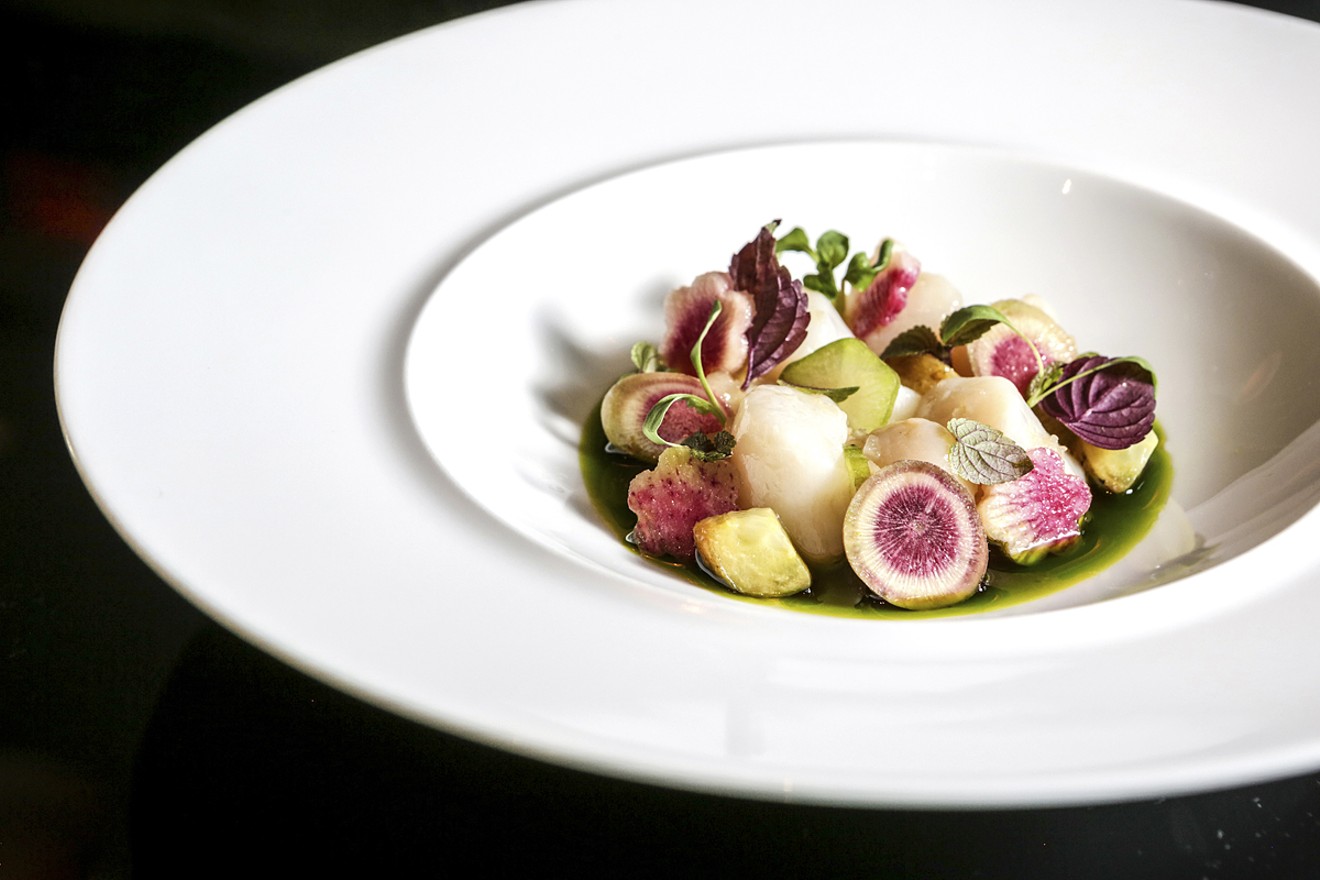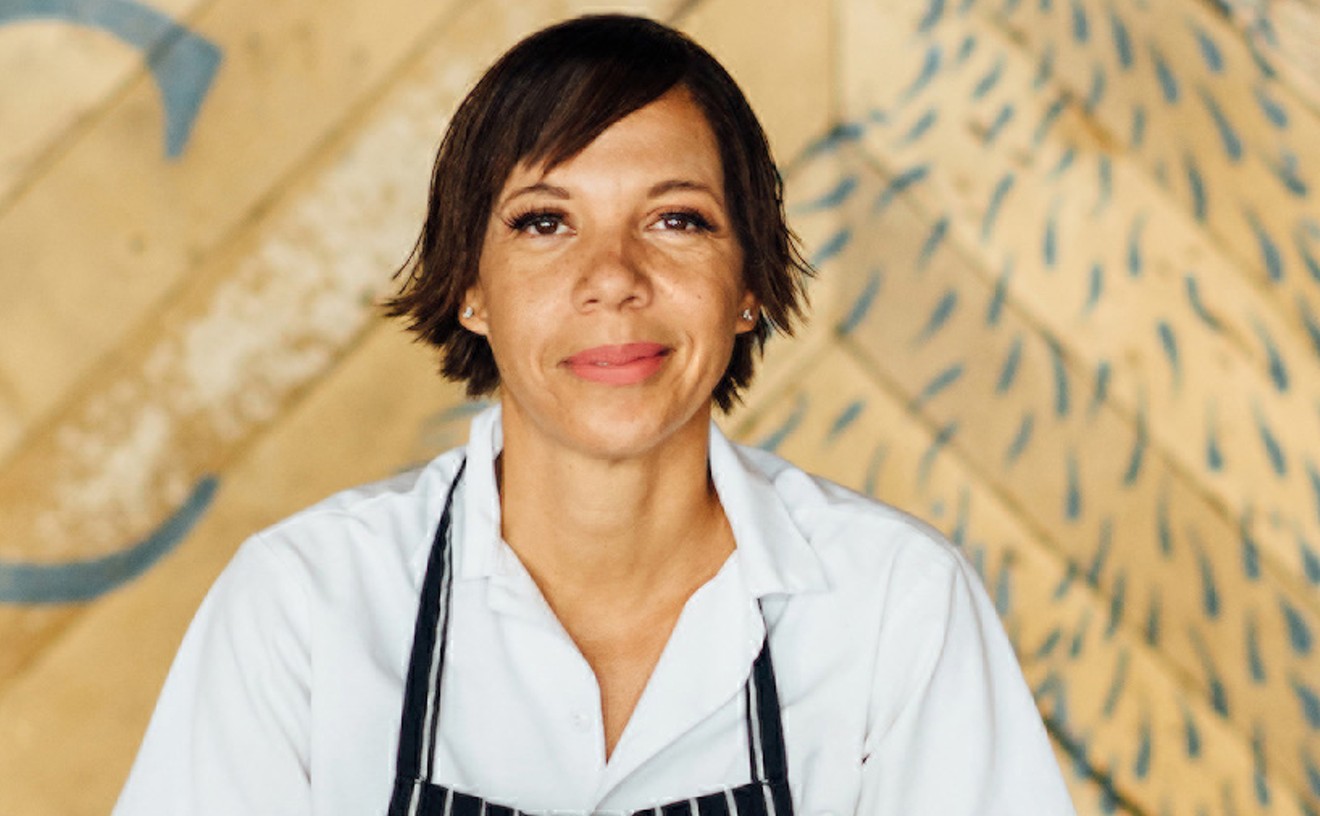A young waiter clad in a light-blue long-sleeve shirt and a fitted apron heads toward a table where a couple was recently seated. He presents the middle-aged man in a blue tie and young lady with perfectly trimmed brown hair with two small plates of bite-size, glistening golden-brown wheat rolls. They're accompanied by creamy Vermont butter spiced with sea salt and cumin, then drizzled with maple syrup. An intoxicating aroma fills the room.
The waiter heads back to the kitchen at Norman Van Aken's new Wynwood place, Three (50 NW 24th St., Miami; 305-748-4540), as the pair quickly gobbles up the rolls. A few minutes later, when the waiter returns, the woman asks for a second serving. "We can get more of that, right?" she asks, pointing to the now-empty plate.
"That's not possible," the waiter replies before clearing the table for the first course. "The rule is one per diner."
The encounter is emblematic of both the amazing potential and the early shortcomings of Van Aken's Three, which opened this past November and is perhaps the most ambitious dining project yet in the Wynwood juggernaut. Located just a stone's throw from the Salty Donut, the place is 66-year-old Van Aken's attempt to make fine dining fashionable.
The restaurant appears slightly misplaced, like a dad struggling to be cool.
tweet this
The stocky chef with a spiky white beard also opened the neighborhood's first rooftop bar, No. 3 Social, upstairs. And next door, he will begin operating In the Kitchen With Norman Van Aken, a cooking school for enthusiasts, expected to open this month.
Three, though, is the heart of the operation. Here, Van Aken cooks his signature Florida fusion cuisine in a sleek and tropical space. The staff is disciplined, and the food is topnotch. It's the sort of fine dining that fans of this Mango Gang legend expect.
But amid throngs of 20-somethings on the way to spots such as 1-800-Lucky and Coyo Taco, this restaurant appears slightly misplaced, like a dad struggling to be cool.

The restaurant, bar, and cooking school cover more than 7,000 square feet in a neighborhood overrun by construction and rising real-estate prices. Van Aken and business partners Candace Walsh and Susan Buckley are betting a quality $60, three-course meal will appear more attractive than a $5 taco.
Born in northern Illinois, Van Aken is a college dropout with no formal training. He reached prominence in the late '80s at Louie's Backyard in Key West, a waterfront icon famous for Caribbean-American cuisine.
In 1995, he opened Norman's in Coral Gables, where he put South Florida's own fusion cuisine on the map with yuca-stuffed crispy shrimp and roast pork with Haitian grits. There, he earned numerous James Beard Award nominations and praise from culinary legends such as Emeril Lagasse, Wolfgang Puck, and the late Charlie Trotter.
In 2003, he opened Norman's at the Ritz-Carlton Orlando, which recently celebrated its 15th anniversary. Four years later, as rents skyrocketed in the Gables, the original Norman's closed. In 2011, he took the helm at Miami Dade College's Miami Culinary Institute and its downtown penthouse restaurant, Tuyo.
Around the same time, he opened a short-lived place in the Gables and started a restaurant in Mount Dora, but he became increasingly fascinated with the idea of opening a cooking school. He considered moving to the Vagabond Hotel on Biscayne Boulevard, but his business partners led him to the Wynwood Arcade instead. The recently built property had room not only for a school but also a restaurant and a rooftop bar. Van Aken was sold.
On a recent Saturday night, the dining room was about half full. It's outfitted with midcentury modern furnishings such as royal-blue velvet chairs and sleek gold-trimmed black tables. An impressive Frida Kahlo portrait hangs adjacent to a marble bar facing an open kitchen. Diners interacted with chefs there during a meal.

The design is similar at the upstairs bar, which includes low-slung lounge chairs and a sparkling bar lined with hundreds of wine and spirit bottles. It wasn't nearly as crowded as nearby icons such as the Wynwood Yard and El Patio. Time will tell if Three can build a following willing to pay prices slightly higher than many others in the neighborhood. (Drinks average $15.)
Downstairs, the menu changes as frequently as once a week and lists no prices. Diners are encouraged to choose three courses, one from each section, for a total of $60. Or they can leave it up to Van Aken and his chef de cuisine, Miguel Massens — a Cuban-American toque who has worked for the likes of Thomas Keller and Daniel Boulud — for a $90 five-course tasting menu.
An á la carte menu is also available, but you have to demand it. Depending upon whom you ask, you might be told it doesn't exist. Van Aken says he wants to encourage diners to enjoy the full restaurant experience of three courses.
The best part of dinner comes at the beginning and is unrelated to your desired menu. All meals start with the decadent bread and spiced butter, compliments of the chef. An individual wheat roll, about the size of one's palm, is served warm. Pace yourself. Second servings are often prohibited.
Then comes the first course, composed of light items that are pricey and small. The Thai garden salad, where a single heap of lettuce is placed atop a spread of tamarind-peanut dressing, bursts with tangy flavor ($14). The creamy cracked conch chowder, a favorite for its warm and comforting flavor, is made with coconut milk with dashes of saffron and citrus that give it an edge ($18). The Nantucket bay scallops aguachile is reminiscent of ceviche. Here, fewer than a dozen tiny pieces of scallop are submerged in a liquid seasoned with watermelon radishes, cucumber, and shiso ($18).
The second course is a tad larger. The Spanish calasparra rice stands out for its vibrant fire-roasted red pepper sauce and a generous smattering of Manchego cheese ($18). There's also a calabaza talkari, comparable to a vegetable curry, made with tempura squash blossoms, curried pepitas, stracciatella, and brown butter honey. ($16).

Dinner ends with a fish or meat item. The swordfish, served lightly grilled, came dense and slightly dry. But a bed of Peruvian chaufa fried rice redeemed the plate. Cooked with shiitake mushrooms and a koi soy reduction, the rice maintains a toothsome texture and an enjoyable smoky aftertaste ($32). The porcelet chop, one of the largest and most filling plates, is tender and tasty, though the Calico Sea Island rice and peas falls flat in flavor ($38). There is also a prime beef strip-loin steak, whose Creole mustard crust and lone quail egg add some oomph ($48).
Dessert is not included in the three-course meal, but it should not be missed. Pastry chef Mame Sow is responsible for a slate of beautifully crafted and rich creations ($12 each). Among them, the peanut opera cake shines. Filled with a milk chocolate chantilly and coated with additional chocolate and candied peanuts, it's a pleasurable way to finish a meal and will ensure you leave full.
Overall, the $60 prix fixe is a better deal than ordering á la carte, but don't forget, that price doesn't include drinks, dessert, tax, or tip.
In the end, it's exciting to see Van Aken back in Miami serving the cuisine that transformed the city into a robust dining destination. But he would do well to loosen the reins and allow diners more flexibility. Three requires time for a lengthy meal and comes at a high cost in an area famous for inexpensive, edgy, and delicious fast-casual dining.
When the cooking school debuts, it might help attract clientele, but until then, there is no way to know whether Miami's hipster neighborhood will make Three as successful as some of the other jammed neighborhood haunts.












